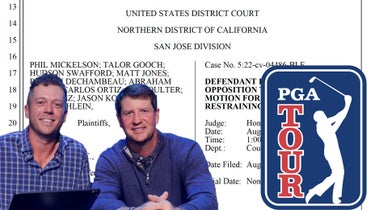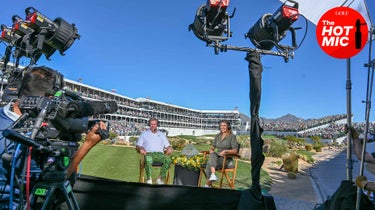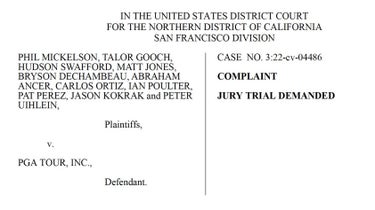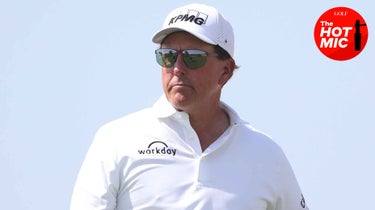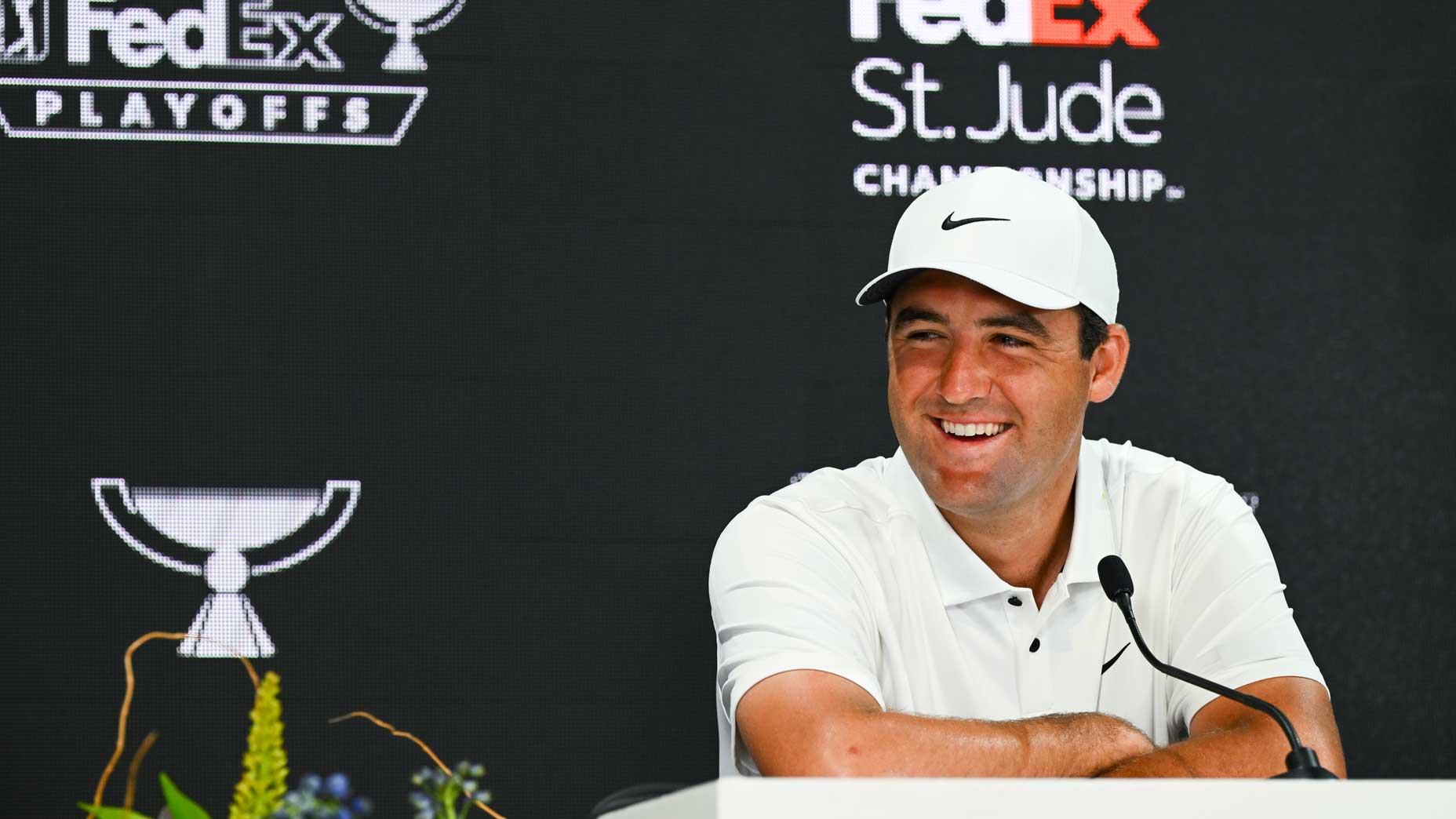
The PGA Tour’s media rights are at the center of its massive lawsuit with LIV Golf, but why?
Getty Images
The future of golf as we know it may very well depend upon the sport as we see it.
After a lawsuit, two filings and more than 140 pages of legalese from both sides of the PGA Tour and LIV Golf divide, golf’s biggest courtroom moment in decades is upon us, and media rights are at the center of all of it.
If you’ve taken even a quick skim through the filings from either side, there are overwhelmingly good odds you found yourself reading about the PGA Tour’s media rights policy. Between the two filings, “media rights” are referenced a whopping 98 times, while lawyers from both sides carefully explain their view of the Tour’s policy and its effects on players.
The crux of the argument for both sides surrounds the Tour’s enforcement of its media rights policy, the rules that govern the Tour’s television deals. In a nutshell, the lawyers for LIV argue these rules are unlawfully broad to the degree of being “monopolistic,” suppressing players of their rights and freedom to play outside of the PGA Tour. Lawyers for the Tour argue the rules have quite the opposite effect, encouraging competition between the Tour and LIV for the game’s top players.
But what even are the PGA Tour’s media rights agreements, and why do they have such a grip on pro golf’s future? Let’s take a closer look at the arguments presented by either side.
The Big Picture
On a surface level, the PGA Tour’s media rights agreements are no different than those in any other professional sport. As part of the agreement, the Tour sells the exclusive right to broadcast its events to a broadcast network, who in turns pays a large sum (a ‘rights fee’) to the PGA Tour.
Like every other major professional sport, rights deals are the lifeblood of the PGA Tour’s business apparatus, bringing in more than $600 million annually through agreements with both domestic partners (NBC, CBS and ESPN+) and international ones (Discovery). And just like every other professional sport, the value of the rights agreement is inextricably tied to its scarcity. Think about it logically: if every channel could broadcast the PGA Tour on Sunday afternoon, CBS and NBC would have no reason to pay the PGA Tour an exorbitant fee to do the same. It is in the best financial interest of both the Tour and its broadcast partners to license media rights on an exclusive basis, which is exactly what they did.
But this is where things get weird. Unlike other professional sports, the PGA Tour does not have “owners,” which means its players are not contract employees but “members” (what the Tour calls “independent contractors,” for tax purposes). This means the Tour does not have the authority to impose exclusivity rules, but rather that the players must agree to surrender them. At the beginning of every season, Tour players are required to sign an affidavit handing over their exclusive media rights to the Tour.
Yes, the “exclusivity clause” (as it has come to be known) guarantees broadcasters the exclusive rights to broadcast PGA Tour golf — but it effectively also guarantees broadcasters the exclusive rights to PGA Tour players. As part of the agreement, players agree “not to play in, and thereby contribute their media rights to, non-Tour golf events held in North America that conflict with PGA Tour events,” according to the Tour’s own court filing. With PGA Tour events happening almost every week of the year, these rules represent near-blanket control of player media rights.
The Tour contends that the inherent value of its TV deals is attached to the enforcement of these agreements. In agreeing to hand over more than $600 million per year, the Tour’s media partners are paying to be only the show in town.
But what happens when a player wishes to play in a non-PGA Tour event outside North America? He requests a “Conflicting Event Release,” asking the PGA Tour to waive his media rights for the week in order to compete elsewhere. While the Tour has historically granted player release requests, it retains the authority to deny them if “the commissioner determines that it would cause the Tour to violate a contractual commitment to a tournament sponsor or would otherwise significantly and unreasonably harm the Tour and its sponsors.”
LIV’s Side
In handling player defections to LIV, the PGA Tour has relied heavily upon its enforcement of media rights rules, citing the agreements as one of the primary justifications for handing down unprecedented suspensions to players. This decision has drawn the ire of LIV players (and their lawyers), who argue the rules are both unlawfully created and enforced.
According to the lawsuit, LIV views the media rights rules as an overreach by the PGA Tour, a measure aimed at restricting players of their rights as independent contractors while serving no meaningful purpose to benefit them.
“In short, these regulations—the Media Rights Regulation and the Conflicting Event Regulation—foreclose the players, who are independent contractors, from participating in any golf event that the PGA Tour deems to be a competitive threat,” the lawsuit reads. “These provisions limit output by keeping golfers on the sidelines when not playing on the Tour. And these provisions, in turn, foreclose competition and entrench the PGA Tour’s monopoly power.”
According to LIV, the Tour’s media rights rules were created with the intent of suppressing meaningful competition, refusing players the right to compete as they wish and, in turn, harming the growth potential of an upstart new league. In the suit, LIV contends the Tour’s rules hurt interest in the new league from players and broadcasters, both of whom were reticent to partner with the upstarts given the Tour’s outstanding agreements.
In all, LIV argues that the Tour’s media rights are a prescient example (and perhaps the prescient example) of its monopoly over the golf space. As such, LIV says, the player suspensions levied as a result of it should be thrown out, and players should be permitted to compete on both tours.
These provisions, in turn, foreclose competition and entrench the PGA Tour’s monopoly power.
The PGA Tour’s Side
In the Tour’s view, the debate over media rights is really a debate over membership rights, emphasizing that PGA Tour membership is not an unassailable right afforded to those who earn it, but rather a business partnership requiring a good faith effort from both sides.
“The Tour’s eligibility and media rights provisions are analogous to an exclusive services contract,” the Tour writes in its filing, justifying its suspensions of LIV players by arguing those players knowingly violated the terms of their media rights agreement.
“What Plaintiffs cannot do, however, is enter into annual agreements with the Tour that grant the Tour their media rights, breach those agreements by granting conflicting media rights to LIV, and then force the Tour to allow LIV to freeride off the Tour’s investment and goodwill by compelling the Tour to allow Plaintiffs to play in both Tour and LIV events.”
In fact, the Tour argues, the enforcement of its media rights rules actually improves the competitive environment in professional golf, “requiring the Tour and LIV to compete vigorously against one another to attract and retain the top players, which is already occurring.”
In both court filings and public remarks, the Tour has repeatedly referred to LIVers as “freeriders” — a point meant to emphasize established precedent that forced separation of entities improves the overall competitive environment, undermining LIV’s “monopoly” argument and its justification for wanting membership on both tours.
On the topic of independent contractor status, the Tour argues it has the freedom to enforce its rules as it so chooses, including by suspending those who violate them. After all, the Tour says, antitrust laws do not require it “to aid competitors.”
What It All Means
Unsure of how this’ll all shake out in court? You’re not alone! As several legal analysts have pointed out, both LIV and the PGA Tour have brought compelling cases before the court. This won’t be a cut-and-dry decision, and an answer shouldn’t be expected overnight (unless, of course, you’re referring to Talor Gooch, Hudson Swafford and Matt Jones’ case for a Temporary Restraining Order to compete in the FedEx Cup Playoffs, which will be decided on Tuesday afternoon).
Broadly speaking, though, it means that one of sports’ sturdiest institutions is facing an unprecedented legal challenge, the ramifications of which could alter the way the sport is watched — and the people competing in it — in the long-term.
In other words: get your popcorn ready.


